Nine Flavor and Color Developments for Product Formulators
INGREDIENTS
The color and flavor of foods and beverages draw consumers’ attention and keep them coming back for more. Some of the top innovations in these two ingredient categories include global flavors, flavor combinations, and naturally derived colorings—all of which are being used today in foods and beverages on grocery store shelves and in restaurants. Another area of emphasis is on developing more flavoring and coloring options to meet the clean label demands of consumers. And don’t forget about unusual and intriguing flavors that can attract the growing number of consumers looking for the next flavor adventure. (Bird’s nest flavor, anyone?) What follows are nine advances (in no particular order) in flavors and colors that can help product developers take products to the next level.
1. A Shift to Natural Colors
“Natural food coloring is no longer a trend for the future: it is a current reality,” says Nathalie Pauleau, natural colors category manager at Naturex, Avignon, France (naturex.com). “Today, the new market differentiator is not ‘if’ natural flavors and colors are being used but ‘how’ they are being used—how they are used in craft foods, innovative food products, and functional and mainstream foods in order to catch the attention of emerging consumer groups, such as Millennials.”
The push to formulate with naturally derived colors came in the end of the 1990s when the dairy industry in Europe began using these ingredients, says Pauleau. “This industry had a strong healthy food positioning, and moving toward natural colors was an obvious step to take. As yogurts are cold stored, there were few stability issues.” She adds that Europe is still leading all markets in the use of natural colors while other markets are seeing varying levels of growth. “Although North America came to the party late compared to the EU, the move towards natural colorings is now underway among small- and medium-sized companies in North America, because they see it is a means of differentiation and because missing this trend could be a risk for food manufacturers, considering consumers’ interest in natural and healthier foods.” In the United States specifically, a strong wave of using naturally derived colorings came in 2014–2015 as consumers began demanding foods formulated without artificial ingredients and manufacturers of the large food brands started to reconsider their formulations, says Pauleau. “Recent Big Food announcements confirm that because of consumer and health interest groups, the natural color revolution is now in full swing.” Two industries that are at the forefront of reformulating with natural colors are cereal and confectionery, says Pauleau, because “they are targeting children and they feel a need to obtain parents’ trust.”
 Other markets are showing growth in the use of natural colors, but at slower rates than in Europe and the United States. “Consumers in Asia are quite worried about artificial colors: 65% are concerned about the use of artificial coloring in their food. The demand for natural colors is therefore growing in Asia. In Asia as well as in Latin America, the cost of formulating with natural colors can be a limitation in some areas,” says Pauleau.
Other markets are showing growth in the use of natural colors, but at slower rates than in Europe and the United States. “Consumers in Asia are quite worried about artificial colors: 65% are concerned about the use of artificial coloring in their food. The demand for natural colors is therefore growing in Asia. In Asia as well as in Latin America, the cost of formulating with natural colors can be a limitation in some areas,” says Pauleau.
With naturally derived colorings, there are many options that give various shades of red, purple, brown, orange, and yellow. There’s less choice when it comes to coloring options for blue and green. “Although blue is not the most common color found in foods, it is nevertheless a key color in confectionery and a super tool, when combined with yellow pigment, for offering vibrant greens,” says Pauleau. The U.S. Food and Drug Administration’s approval of blue spirulina extract (2013 with an extension in 2014) opened up new possibilities for the development of natural blue and green shades and made it possible to match artificial Brilliant E133 and FD&C Blue #1 in confections, pastry decorations, and frozen desserts and ice cream, she adds. Enhancements to extraction and formulation have helped to improve the stability of spirulina-based pigments. This has allowed Naturex to develop VegeBrite Ice Blue, which offers higher stability to temperature and a lower pH than the standard on the market, and VegeBrite miChroma Blue Spirulina, which provides an innovative oil-dispersible formulation for fat applications, says Pauleau. “Our spirulina extracts are already approved in Europe (as coloring foods), the U.S., Canada, Australia, Japan and Korea, and we are working hard to achieve greater worldwide harmonization on this pigment.”
Things get a bit trickier in the development of a naturally derived green coloring. Pauleau says that according to FDA regulation, the main option for green is to combine blue spirulina with yellow pigment (turmeric or carotene). In Europe, manufacturers can use chlorophyll and copper chlorophyllin, but these are not permitted in the United States. “The status of copper chlorophyllin is being discussed in Europe. The European Food Safety Authority has published a report that underlines a lack of toxicological data regarding this pigment and the fact that the addition of copper in the process means that the green product is not fully compliant with the natural policy of some retailers and food manufacturers. In this context, several food manufacturers are moving from copper chlorophyllin to green color spirulina-based or chlorophyll from spinach.”
2. Go Beyond the Obvious Offering
One way to grab the attention of consumers with food and beverage products is to use flavor and color in new and intriguing ways. Trends such as health and wellness, permissible indulgence, and hybrids/mash-ups are driving product development, and Jim Wolfe, senior director of marketing at David Michael & Co., Philadelphia, Pa. (dmflavors.com), gave insights as to how the company’s flavor and color ingredients can help product developers leverage these trends and take products to new levels. Speaking at the 2016 David Michael Innovation Roadshow held in Philadelphia in September, Wolfe encouraged attendees to get inspired by the more than two dozen product concepts developed for the show and to look for opportunities to push the bounds in product development.
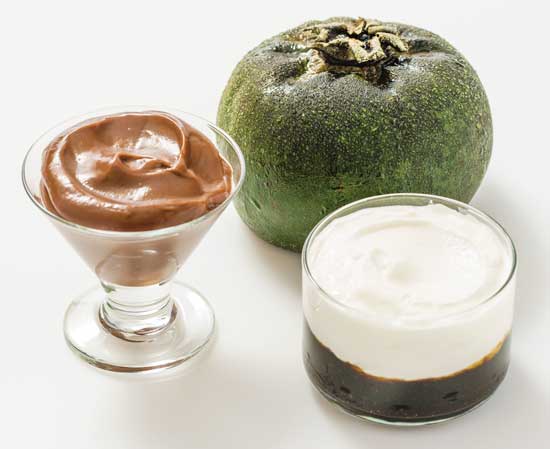 Some of the creative concepts David Michael concocted included Root Vegetable Candy (gummy candies flavored with beet flavor and purple sweet potato flavor), Faux-Ciutto, Apple, and Brie Stuffed French Toast (formulated with prosciutto type, French toast type, and apple pie type flavors), Kansas City Style Barbeque Pulled Pork Flavored Sticky Buns, and Cheese Ice Cream with Pickled Beet Variegate. There were also mini chocolate cups filled with either a strawberry basil–flavored or melon cucumber mint–flavored ganache that employed natural colors derived from beetroot and spirulina blue. Some of the concepts illustrated ways to introduce unfamiliar flavors in a recognizable format. Yogurt and pudding, for example, were flavored with a black sapote flavor. Black sapote is a fruit that has a chocolate flavor. Ice cream featured a flavor based on a Chinese liquor called baijiu, which is a clear spirit made from fermented sorghum with light fruity and slightly sour flavor notes. Jam featured nori flavor (nori is a type of edible seaweed) and a flavor profile similar to Japanese seven-spice blend.
Some of the creative concepts David Michael concocted included Root Vegetable Candy (gummy candies flavored with beet flavor and purple sweet potato flavor), Faux-Ciutto, Apple, and Brie Stuffed French Toast (formulated with prosciutto type, French toast type, and apple pie type flavors), Kansas City Style Barbeque Pulled Pork Flavored Sticky Buns, and Cheese Ice Cream with Pickled Beet Variegate. There were also mini chocolate cups filled with either a strawberry basil–flavored or melon cucumber mint–flavored ganache that employed natural colors derived from beetroot and spirulina blue. Some of the concepts illustrated ways to introduce unfamiliar flavors in a recognizable format. Yogurt and pudding, for example, were flavored with a black sapote flavor. Black sapote is a fruit that has a chocolate flavor. Ice cream featured a flavor based on a Chinese liquor called baijiu, which is a clear spirit made from fermented sorghum with light fruity and slightly sour flavor notes. Jam featured nori flavor (nori is a type of edible seaweed) and a flavor profile similar to Japanese seven-spice blend.
3. Gourmet and Delicacy Flavors
Gourmet ingredients can set products apart from the competition and drive consumer interest, but they can be expensive (truffles) or difficult to source (Kobe beef). A solution is to use flavorings that provide flavor profiles from these ingredients in an easy-to-use and cost-effective way.
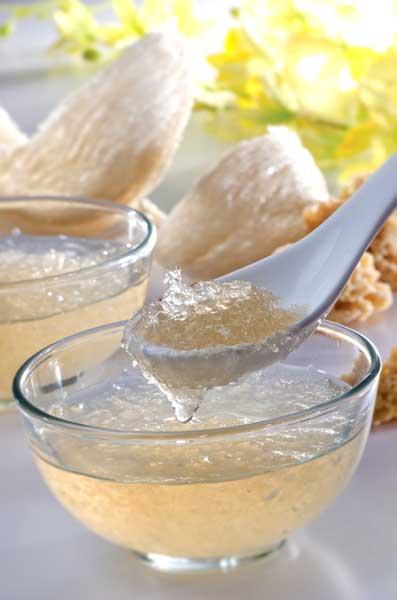 A new line of eight gourmet flavorings from Gold Coast Ingredients, Commerce, Calif. (goldcoastinc.com), covers the flavors from a range of scarce and expensive ingredients. The flavors are vanilla, white and black truffles, saffron, wine (including flavorings that match flavor profiles of different red and white wines found in countries around the world), jamón Ibérico, Kobe beef, and balsamic vinegar. The most unusual in the collection is bird’s nest soup flavor. If you are not familiar with bird’s nest soup, it is a delicacy enjoyed in China and parts of Southeastern Asia that is made from an actual bird nest fashioned from the saliva of a small, cave-dwelling bird called the swiftlet. The saliva strands contain a protein that dries and hardens to form the nest, which people cook in chicken broth to make a savory, gelatinous soup. Some prepare the nests with rock sugar to create a sweet dessert. Gold Coast suggests using its bird’s nest flavor, which has a briny, slightly earthy taste, in soup, prepared foods, and beverages.
A new line of eight gourmet flavorings from Gold Coast Ingredients, Commerce, Calif. (goldcoastinc.com), covers the flavors from a range of scarce and expensive ingredients. The flavors are vanilla, white and black truffles, saffron, wine (including flavorings that match flavor profiles of different red and white wines found in countries around the world), jamón Ibérico, Kobe beef, and balsamic vinegar. The most unusual in the collection is bird’s nest soup flavor. If you are not familiar with bird’s nest soup, it is a delicacy enjoyed in China and parts of Southeastern Asia that is made from an actual bird nest fashioned from the saliva of a small, cave-dwelling bird called the swiftlet. The saliva strands contain a protein that dries and hardens to form the nest, which people cook in chicken broth to make a savory, gelatinous soup. Some prepare the nests with rock sugar to create a sweet dessert. Gold Coast suggests using its bird’s nest flavor, which has a briny, slightly earthy taste, in soup, prepared foods, and beverages.
4. Heat and Spice
Kick up the flavor interest of foods and beverages with a little heat or spice. “Flavor trends that are still hot, no pun intended, are spicy chili peppers from around the globe,” says Kim Cornelius, senior scientist at Wixon, St. Francis, Wis. (wixon.com). “Today’s consumer likes to challenge their taste buds with hotter and hotter items, and they are testing the waters with a variety of chili peppers from around the world, such as Aleppo, gochugaru, and Peruvian ají.” Other peppers like poblano, habanero, and guajillo are becoming more popular too as consumers’ tolerance for spice grows and expands based on the amount of heat flavors in various ranges of intensity that are available in both new product introductions and on the menu, says Pamela Oscarson, consumer insights manager at FONA, Geneva, Ill. (fona.com).
Bob Kaegi, Wixon’s director of protein applications, notes a growing interest in hot flavors for meat applications. “In fact, the hotter the better. Sriracha from China and gochujang from Korea are still going strong. Other peppers that are trending in products that our lab works on are shichimi togarashi from Japan, Trinidad moruga scorpion pepper from Trinidad, and Hatch from the U.S.” Kaegi’s colleague, AnnMarie Kraszewski, R&D lab manager, adds that hot profiles continue to grow as consumers become more aware of what they are eating and more adventurous. “Finding regional peppers and adding those to familiar dishes like mashed potatoes creates a new eating experience.”
Some like it hot, and that’s great, but David Banks, director of market research and consumer insights at Kerry, Beloit, Wis. (kerry.com), says that developers should also look at heat profiles and spicy flavors with nuance. “Americans’ love for heat, especially Millennials, has driven up the Scoville heat scale dramatically over the past 10 years, but we are now seeing a level of complexity enter the picture when it comes to heat. Heat profiles today need to deliver flavor, mouthfeel, umami, and kokumi and not simply burn our taste buds.”
--- PAGE BREAK ---
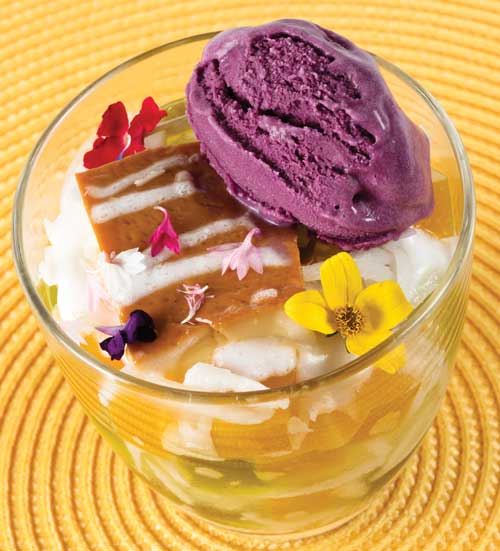 5. Fruits and Vegetables for Color and Flavor
5. Fruits and Vegetables for Color and Flavor
Fruit and vegetable concentrates are attractive options to color and flavor many foods and beverages in a natural, clean label way. Another advantage to using these ingredients is that a little bit goes a long way, says Dawn Merrill, technical services manager at Kerr Concentrates, Salem, Ore. (kerrconcentrates.com). “If a developer is working with a tight cost target, concentrates are a simple solution—and they look great on a label. At just 1% in certain formulas, vegetable concentrates like red beet, purple carrot, and pumpkin will yield brilliant color. Similarly, fruit juice concentrates are added at similar levels to produce a natural fruit flavor and give authenticity to a label.”
Manufacturing these ingredients is fairly straightforward, beginning with running raw fruit or vegetables through a grinder and screen to separate out unwanted solids, explains Merrill. The juice is pasteurized and then it is either filtered or not. The pasteurized single-strength juice is run through a gentle evaporation process until the desired brix level between 40° brix and 70° brix is obtained. The juice concentrates, which are stored frozen, have a shelf life of up to two years.
Merrill says that because the fruit and vegetable concentrates are “completely natural,” heat, light, and oxygen can degrade them so processing and packaging has to be considered before choosing fruit and vegetable concentrates for use as a natural coloring option. “As an example, red beet juice concentrate works well in dairy products like yogurt and ice cream, but the color compounds are susceptible to browning in a baked application. Juice manufacturers can stabilize those color pigments in process, however it’s important to reach out to your supplier so they can help you formulate with the right ingredient for your application.”
As far as what fruits and vegetables are popular right now, Merrill says that watermelon has been a big hit this year, particularly a concentrate that has been processed without the rind and is red in color. “Watermelon can be both sweet and savory, and we’re seeing it pop up in sauces, desserts, and even as natural color in some baked snacks. Custom blends like strawberry watermelon, watermelon lime, and even cucumber watermelon seem to be on trend.” She adds that with autumn upon us, pumpkin, butternut squash, and warm flavors like plum and cranberry have gained customers’ attention. Manufacturers are also using different fruits and vegetables to add twists to foods and beverages. “Consumers are more adventurous today than ever and food companies are responding. We at Kerr love seeing the fruit and vegetable blends pop up in the market. Formulators are getting creative by adding cauliflower in tropical fruit blends, masking kale juice concentrate with red berry fruits, and even mixing sweet and savory together in some applications, and the results are delicious.”
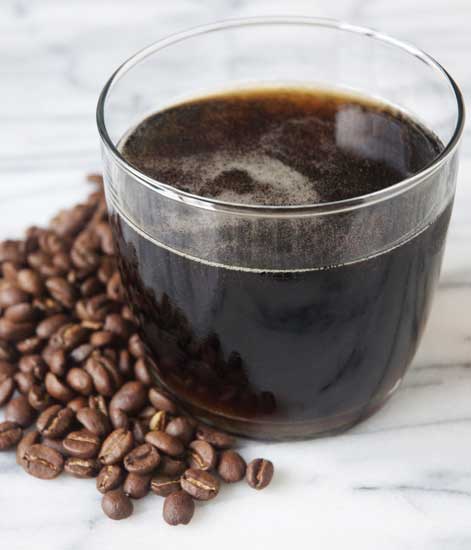 6. Cold Brew Coffee Is a Hot Flavor Trend
6. Cold Brew Coffee Is a Hot Flavor Trend
“Cold brew coffee has been around for centuries and was one of the most closely held secrets in the coffee industry,” says Eric Hinson, national accounts manager for S&D Extracts and Ingredients, Concord, N.C. (sdcoffeetea.com). “Independent coffeehouses have quietly used cold brew coffee to craft signature flavor profiles that set them apart from their competition. The popularity of cold brew coffee in the U.S. has exploded in the last year. According to Mintel, retail sales of RTD cold brew coffee grew 115% in 2015 versus 2014, reaching $7.9 million in sales. As the latest craze, cold brew coffee is moving from small, independent coffeehouses to the mainstream. Chain coffeehouses are moving cold brew from ‘test stores’ to chain-wide execution, while donut shop chains are beginning to test in metro areas.”
The flavor of cold brew coffee differs from traditional brewed coffee, mainly due to how it is prepared (steeping at room temperature for a minimum of 10 hours). “By using time instead of heat, the gentle extraction of cold brew yields an authentic coffee flavor that is perfectly balanced, distinctively smooth, and subtly sweet. Because of the authentic and balanced flavor, cold brew is more often enjoyed pure black or lightly sweetened,” says Hinson. S&D’s 100% Cold Brew Extracts allow product developers to enhance the flavor of black cold brew coffee applications or add the flavor of cold brew coffee to other applications like ice cream and dairy-based frappes, iced coffees, and lattes. “We are seeing cold brew extracts being used behind the bar as well,” he says. “The fusion trend is also catching on in this category as cold brew is used to make refreshing mock-tails with flavored tonic water, deliciously decadent drinks with sweetened condensed milk and fruit, and even chasers for bourbon and other popular alcoholic beverages.”
S&D Extracts and Ingredients produces the cold brew extracts by roasting coffee beans (it is the largest coffee roaster in North America and sources coffee beans from around the world, says Hinson) and performing cold extractions to produce cold brew blends that meet high quality standards. “We don’t take quality lightly. We have one of the few facilities in the industry that is ISO 9001:2008 certified and has a SQF Level 4 certification,” says Hinson. The specific process that the company uses to batch brew and extract the cold brew coffee is called the Toddy Process. “S&D Coffee & Tea was first to market with a cold brew coffee extract that is batch-brewed at scale,” he adds.
7. Clean Label Demand Surge
Product developers hear it all the time: clean label demands are driving product development. These demands have changed the ingredient landscape, with more ingredient manufacturers expanding their offerings of ingredients that are naturally derived or minimally processed, including flavorings and colorings. “Consumers are in search of transparency and clean products,” says Oscarson. “The clean label movement is not a fad. It is the new normal that spans multiple generations and walks of life. As far as the consumer is concerned, clean means healthy. Consumers’ perception of what healthy is no longer involves calories and fat as a main consideration, but recognizable ingredients. Clean means health, and health means longevity. Consumers are concerned about health because they want to be as healthy as possible and they are expecting that from food and beverages.”
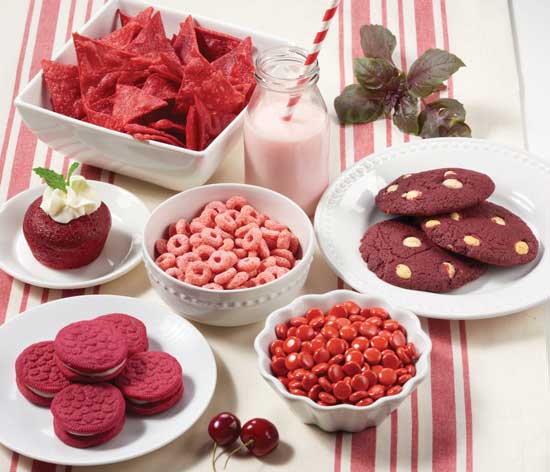 8. Red Coloring Offers Heat Stability
8. Red Coloring Offers Heat Stability
Naturally derived colorings are in vogue. Manufacturers large and small are reformulating with these colorings at the behest of consumers and to remain competitive. But using natural colorings is not without challenges. Light, oxygen, heat, processing, pH, and time can degrade colorings from natural sources. A heat-stable naturally sourced red color has been elusive until now. Scientists at Sensient Colors, St. Louis, Mo. (sensientfoodcolors.com), developed a new naturally derived red color that gives varying shades of red to foods like neutral pH baked goods and dry products like cookies, extruded cereal, red licorice, and tortilla chips while remaining heat stable.
SupraRed, which made its debut at the IFT16 show in Chicago, is derived from beets. Unlike standard beet-based colorings, which are prone to browning during heat processing, SupraRed is sourced from beets that undergo a proprietary solvent-free, natural color technology that increases the heat stability of the final ingredient, according to David Rigg, director of global food marketing for Sensient Color. The ingredient is also stable in a neutral pH environment. Rigg, who was available at IFT16 to discuss the new coloring ingredient with customers and members of the press, pointed to application visuals that compared SupraRed with standard beet juice and Red 40 to show the ingredient’s capabilities. SupraRed is label-friendly; it is listed as vegetable juice or beet. Rigg also mentioned that manufacturers can use SupraRed with other naturally derived ingredients like cocoa powder or turmeric to create darker or lighter shades of red. The ingredient is available in both liquid and powder forms.
--- PAGE BREAK ---
9. Adventurous Flavors From Around the World
“Global and regional flavors continue to trend across the flavor landscape, and we’re seeing interest in regions that are farther afield than ever before,” says Roger Lane, marketing manager at Sensient Flavors, Hoffman Estates, Ill. (sensientflavorsandfragrances.com). “We’ve begun to see influence from Middle Eastern and African cuisines cropping up as chefs look for the ‘next big thing’ in inspiration for their menus. Think harissa, dukkah, or berbere here.” In addition to global flavors, Lane and his team at Sensient have noticed the use of more U.S. regional flavors, everything from Hatch chile flavor from New Mexico to regionally authentic barbecue flavor from North Carolina.
“Cuisine has become a hot topic in today’s popular culture,” says Banks. He points to food-centric content on social media and food-focused magazines and television shows as drivers of this popularity. “Concurrently, consumers are exhibiting a growing appreciation for worldly experiences, and households are becoming more multicultural,” he adds. “As a result, consumers have a new curiosity and desire for enriched eating experiences. We’re seeing heightened consumer appetite for new flavors and flavor combinations, an openness to trying exotic flavors and a willingness to try food mashups or ethnic and fusion cuisine.” This gives product developers a great opportunity to use flavor to capture the attention of consumers, whether they have an adventurous palate or not. “Don’t be afraid to play with flavor and put your own unique spin on trends you hear about,” says Lane. “There’s a huge trend of flavor fusion out there right now, so it’s almost impossible to go wrong when creating new products. Consumers are looking for adventure when they eat, and products that use flavor in creative ways will get consumers interested.”
Sandi Balco, vice president of research & development and Innovation at Wixon, also notes the increasing interest in global flavors among American consumers. She sees foods and ingredients from different global cuisines being combined in exciting ways. “Over the past year, we’ve seen Korean and North African more frequently, and lots of fusion mash-up flavors. In the past, ‘fusion’ used to be two cuisines from different cultures combined into one product or flavor. Now there are mash-ups of different ethnic flavors combined with product bases that are repurposed into completely new food experiences for consumers, and different types of foods being combined into a single product.”
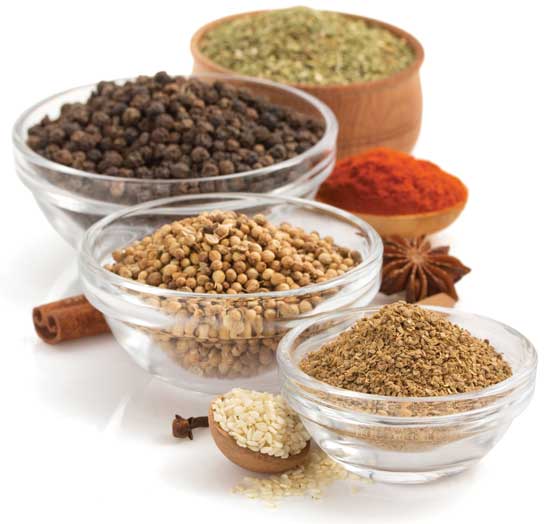 Taking this approach to combining flavors from around the world allows product developers and culinary professionals to flex their creative muscles. Cornelius has worked on flavor fusion projects that combine flavor and ingredients of Mediterranean and Latin and Mediterranean and African cuisines. “We see crossover with spices such as cumin, oregano, mint, and thyme in all of these cuisines, so melding these ethnic flavors together has been relatively easy,” she says. Other combinations of cuisines like Mexican and Asian, African and American, and American and Vietnamese can lead to some surprising results. “This approach not only delivers the authentic flavor profiles consumers seek, such as sweet/heat and sweet/savory, but also completely novel experiences such as spicy nacho cheese donuts or macaroni crust pizza,” says Banks.
Taking this approach to combining flavors from around the world allows product developers and culinary professionals to flex their creative muscles. Cornelius has worked on flavor fusion projects that combine flavor and ingredients of Mediterranean and Latin and Mediterranean and African cuisines. “We see crossover with spices such as cumin, oregano, mint, and thyme in all of these cuisines, so melding these ethnic flavors together has been relatively easy,” she says. Other combinations of cuisines like Mexican and Asian, African and American, and American and Vietnamese can lead to some surprising results. “This approach not only delivers the authentic flavor profiles consumers seek, such as sweet/heat and sweet/savory, but also completely novel experiences such as spicy nacho cheese donuts or macaroni crust pizza,” says Banks.
A big influence in the popularity of these and other global flavors is the street food and food truck scene. “The street food and food truck phenomenon has provided consumers the opportunity to enjoy kimchee tacos, poutine, and ramen burgers, where the ‘bun’ is made of noodles to play off the growing popularity of noodles and ramen in the United States,” says Balco. “These products are now showing up in restaurants and supermarkets. It’s fascinating to see trends starting with street food rather than with white tablecloth restaurants or higher-end foodservice where early adopters would gradually help move new flavors and foods into the mass market.”
Next month’s Ingredients section will review new developments in grains.
Ingredient Roundup
Colorings come in a variety of hues and formats. Manufacturers also have many clean label, naturally derived options available. Check out these suppliers for the latest solutions for coloring needs.
• Stability can be a concern when using naturally derived colorings, so Chr. Hansen, Milwaukee, Wis. (chr-hansen.com), offers Ultra Stable Red and 3rd generation encapsulated colors. Both were developed using technology to improve performance and stability in several food and beverage applications.
• Through its Color Garden line, ColorMaker, Anaheim, Calif. (colormaker.com), offers Pure Natural Food Colors. These are made from naturally derived sources like purple carrot juice, beet juice, turmeric, annatto, and red cabbage juice and are used to color royal icing, buttercream frosting, and sanding sugar.
• One of the newest colorings from DDW, Louisville, Ky. (ddwcolor.com), is an anthocyanin coloring derived from purple corn using a water extraction process. The coloring can provide shades of red and purple.
• San Joaquin Valley Concentrates, Fresno, Calif. (sjvconc.com), produces naturally derived red colorings such as grape juice concentrates and anthocyanin-based colorings. They’re made without the use of additives or extractants.
• For manufacturers looking for caramel colors that are not genetically modified, Sethness Products Co., Skokie, Ill. (sethness.com), offers a line of caramel colors that have been Non GMO Project Verified. One of the colorings is Darkest Class I Powdered Caramel Color SB245, which gives a darker brown color than traditional Class I powders.
What’s New in Flavor Trends
The flavor experts interviewed for this article had plenty to say about trends affecting the flavor of foods. Here’s their take on more flavor trends to watch.
• Pamela Oscarson, consumer insights manager, FONA: “Flavors like passionfruit, guava, dragon fruit, and rambutan are all growing as consumers are in search of a taste of the tropics without ever actually having to leave home.” She adds that flavors like s’mores, cupcake, and doughnut are moving beyond desserts and sweet treats and into beverages and confections.
• Elsa Howerth, principal scientist/senior flavorist, Kerry: “As consumers continue to look for authentic eating experiences, even simple flavors are becoming more complex. Vanilla is a perfect example.” Each vanilla-growing region produces vanilla with specific flavor and aroma characteristics.
• Roger Lane, marketing manager, Sensient Flavors: Lane explains that Sensient has developed several flavors like grilled lemon and charred coconut to play upon the growing popularity of smoked and grilled callouts on menus.
• Ralph Krawczyk, food technologist, Wixon: Krawczyk points out an interest in using bourbon flavors in meat applications this year. “Most of these were fresh and precooked sausage, but there seem to be opportunities in sauces and rubs as well.”
• David Banks, director of market research and consumer insights, Kerry: One broader trend Banks sees is customization. “Consumers want foods and beverages tailored to their needs and tastes, such as chips with shake-on flavors, which allow for as much or as little flavor as they desire. We are seeing snacks with different flavor and shape options packaged together to allow consumers to choose what flavors they want to focus on.” Another area that offers flavor inspiration is the culinary realm. “Consumers’ heightened appreciation for cooking and flavor is translating into a new acceptance of smoked, charred, and burnt flavors, in order to bring specific flavor notes to the forefront. In the past, a consumer may have taken these cooking methods as a kitchen nightmare; now they are appreciating the flavor nuances each of these styles delivers.” Finally, he says smoking, fermenting, and pickling are “giving simple flavors a new air of sophistication.”
• AnnMarie Kraszewski, R&D lab manager, Wixon: Kraszewski sees customers calling out interesting ingredients that provide flavor, like green tea, rose, tarragon, or Hatch chili ranch, as well as requesting combinations of sweet and hot and sweet and spicy. “Cooking and processing methods, along with culinary cues, are also popular, with burnt, charred, pickled, and smoked particularly hot trends combined with other flavors.”
Flavor-Enriching Umami
One way to give a pleasant savory flavor boost to foods is with umami-rich ingredients like soy sauce. Kikkoman Sales USA, San Francisco, Calif. (kikkomanusa.com/foodmanufacturers), has developed a comprehensive portfolio of soy sauces that offer clean label, flavor-enhancing solutions to manufacturers. “High levels of glutamic acid found in fermented foods like traditionally brewed soy sauce triggers the flavor of umami in the mouth,” says Yusuke Hiraiwa, industrial business/R&D manager. “For this reason, soy sauce has become a common supplement for salt in formulations as it adds considerable savory flavor, without the same amount of sodium per tablespoon.”
Kikkoman offers four soy sauces that are Non-GMO Project Verified and has also formulated certified gluten-free traditionally brewed soy sauces that use rice instead of wheat, adds Hiraiwa. “These soy sauces deliver the same rich, umami flavor profile and processing benefits as our regular soy sauces without the gluten. Due to high demand, we even created a granulated tamari soy sauce that is perfect for dry formulation, instantly dispersible, soluble in water, and less susceptible to caking.”
www.ift.org
Online Exclusive: Read more about how to add flavor to food and beverage products in the online exclusive, Four Tips for Developing Flavorful Foods and Beverages, at ift.org/food-technology/current-issue.aspx.
 Karen Nachay,
Karen Nachay,
Senior Associate Editor
[email protected]
